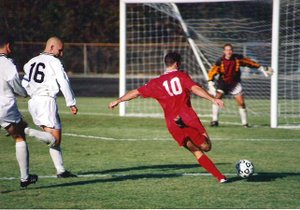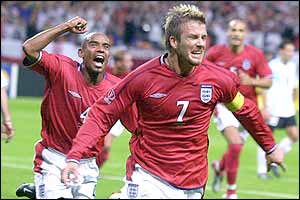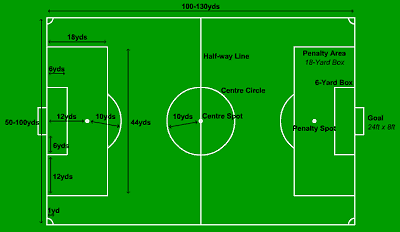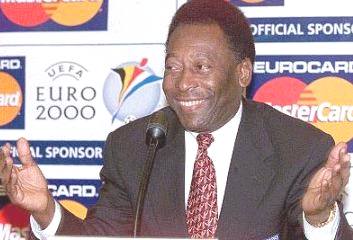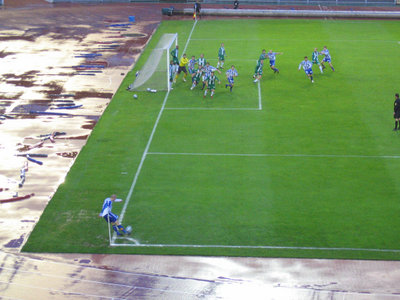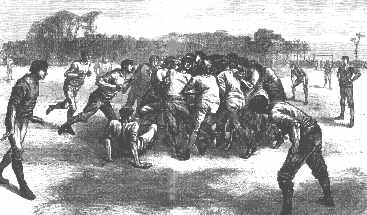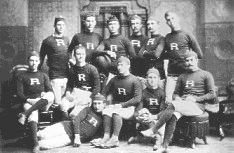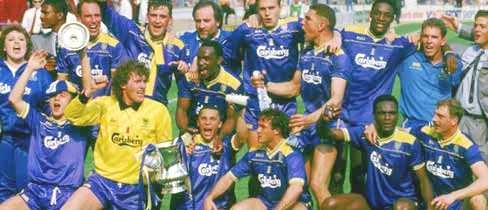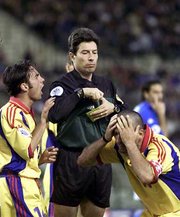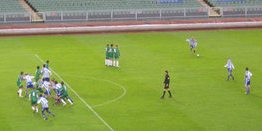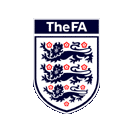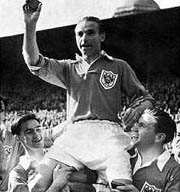|
FOOTBALL
|
||||||||||
|
Football is the name given to a number of different team sports. The most popular of these are Association Football (also known as soccer), American football, Rugby football, Australian Rules football, Gaelic football, and Canadian football.
All of these games involve scoring points with a round or ellipsoid ball (itself called a football), by moving the ball into, onto or over, a goal area or line defended by the opposing team. Many of the modern games have their origins in England, but — since ancient times — many peoples around the world have played games which involved kicking and/or carrying a ball.
SUMMARY
The object of all football games is to advance the ball by kicking, running with, or passing and catching, either to the opponent's end of the field where points or goals can be scored by, depending on the game, putting the ball across the goal line between posts and under a crossbar, putting the ball between upright posts (and possibly over a crossbar), or advancing the ball across the opponent's goal line while maintaining possession of the ball.
In all football games, the winning team is the one that has the most points or goals when a specified length of time has elapsed.
DEVELOPMENT OF THE GAME
Throughout the history of mankind the urge to kick at stones and other objects must have inevitably led to many early activities involving kicking and running with a ball. Football-like games undoubtedly predate recorded history in all parts of the world and the earliest forms of football can only be guessed at.
Ancient games
Documented evidence of what is possibly the oldest organised activity resembling football can be found in a Chinese military manual written during the Han Dynasty in about 2nd century BC. It describes a practice known as "tsu chu" (蹴鞠 or 蹴踘 Pinyin: cù jú) which involved kicking a leather ball through a hole in a piece of silk cloth strung between two 30 foot poles. It was not a game as such but more of a spectacle for the amusement of the Emperor and it may have been performed as long as 3000 years ago.
Another ball-kicking game of Far Eastern origin that may have been influenced by tsu chu is "kemari" which is known to have been played within the Japanese imperial court in Kyoto from about 600AD. In kemari several individuals stand in a circle and kick a ball to each other, trying not to let the ball drop to the ground (much like keepie uppie). The game survived through many years but appears to have died out sometime before the mid 19th century. In 1903 in a bid to restore ancient traditions the game was revived and it can now be seen played for the benefit of tourists at a number of festivals.
The Greeks and Romans are known to have played many ball games some of which involved the use of the feet. The Roman writer Cicero describes the case of a man who was killed whilst having a shave when a ball was kicked into a barbers shop. The Roman game of Harpastu is believed to have been adapted from a team game known as "επισκυρος" (episkyros) or pheninda that is mentioned by Greek playwright, Antiphanes (388-311BC) and later referred to by Clement of Alexandria. The game appears to have vaguely resembled rugby.
There are a number of less well-documented references to prehistoric, ancient or traditional ball games, played by indigenous peoples all around the world. For example, William Strachey of the Jamestown settlement is the first to record a game played by the Native Americans called Pahsaheman, in 1610. In Victoria, Australia, Australian aborigines played a game called Marn Grook. An 1878 book by Robert Brough-Smyth, The Aborigines of Victoria, quotes a man called Richard Thomas as saying, in about 1841, that he had witnessed Aborigines playing the game: "Mr Thomas describes how the foremost player will drop kick a ball made from the skin of a possum and how other players leap into the air in order to catch it." It is widely believed that Marn Grook had an influence on the development of Australian Rules Football (see below). In northern Canada and/or Alaska, the Inuit (Eskimos) played a game on ice called Aqsaqtuk. Each match began with two teams facing each other in parallel lines, before attempting to kick the ball through each other team's line and then at a goal. The ancient Aztec game of ollamalitzli also involved kicking a ball, but it generally had more similarities to basketball.
These games and others may well stretch far back into antiquity and have influenced football over the centuries. However, the route towards the development of modern football games appears to lie in Western Europe and particularly England.
David Beckham
Mediæval football
The first description of football in England is given by William FitzStephen (c1174-1183). He described the activities of London youths during the annual festival of Shrove Tuesday. "After lunch all the youth of the city go out into the fields to take part in a ball game. The students of each school have their own ball; the workers from each city craft are also carrying their balls. Older citizens, fathers, and wealthy citizens come on horseback to watch their juniors competing, and to relive their own youth vicariously: you can see their inner passions aroused as they watch the action and get caught up in the fun being had by the carefree adolescents".
The game played in England at this time may have arrived with the Roman occupation, but there is little evidence to indicate this. Reports of a similar game being played in Brittany, Normandy and Picardy known as "Choule" or "Soule" suggest that it could have arrived with the Norman Conquest.
The Middle Ages saw a huge rise in popularity of annual Shrovetide football matches throughout Europe and particularly in England. These chaotic games would be played between neighbouring towns and villages in which an unlimited number of players on opposing teams would clash in a heaving mass of people struggling to drag an inflated pig's bladder by any means possible to markers at each end of a town. A legend that these games in England evolved from a more ancient and bloody ritual of kicking the "Dane's Head" is unlikely. Shrovetide games are still played in a number of English towns such as Ashbourne in Derbyshire and Sedgefield in County Durham.
Most of the early references to the game speak simply of "ball play" or "playing at ball" and not "football" leading to speculation that the games played at the time did not necessarily involve the ball being kicked. However, in 1424, James I of Scotland issued an edict to ban the playing of "fute-ball".
The first reference to football in Ireland occurs in the Statute of Galway of 1527, which allowed the playing of football and archery but banned "'hokie' - the hurling of a little ball with sticks or staves" as well as other sports. (The earliest recorded football match in Ireland was one between Louth and Meath, at Slane, in 1712.)
The modern spelling of the word "football" is first recorded in Shakespeare's play King Lear, which was first published in 1608: "Nor tripped neither, you base football player" (Act I Scene 4). Shakespeare also mentions the game in A Comedy of Errors (Act II Scene 1):
Spurn literally means to kick away, thus implying that the game involved kicking a leather ball between players.
Calcio Fiorentino
In the 16th century, the city of Florence celebrated the period between Epiphany and Lent by playing a game known as "o Calcio storico" ("kickball in costume") in the Piazza della Novere or the Piazza Santa Croce. The young aristocrats of the city would dress up in fine silk costumes and embroil themselves in cross between football and wrestling. It was a mass brawl in which kicking, punching, shoulder charges, and hitting below the belt were all allowed, and it probably originated as a military training exercise. The most famous match took place on 17 February 1530. Whilst the troops of Charles V, Holy Roman Emperor were besieging Florence a game of "calcio" was organised as a show of defiance. In 1580 Count Giovanni de' Bardi di Vernio wrote "Discorso sopra 'l giuoco del Calcio Fiorentino." This is sometimes credited as the earliest known published rules of any football game. The game was played up until January 1739 but it was revived in May 1930 to celebrate the 400th anniversary of this famous match and is still played as a tourist attraction today.
The football pitch
Attempts to ban football
Numerous attempts have been made throughout history to ban football, particularly in its most rowdy and disruptive forms. King Edward II was so troubled by the unruliness of football in London that on April 13, 1314 he issued a proclamation banning it. It read "Forasmuch as there is great noise in the city caused by hustling over large balls from which many evils may arise which God forbid; we command and forbid, on behalf of the King, on pain of imprisonment, such game to be used in the city in the future." Between 1324 and 1667, football was banned in England alone by more than 30 royal and local laws.
The reasons for the ban by Edward III, on June 12, 1349, were explicit: football and other recreations distracted the populace from practising archery, which was necessary for war, and after the great loss of life that had occurred during the Black Death, England needed as many archers as possible.
The game featured in similar attempts by monarchs to ban recreational sport across Europe. In France it was banned by Phillippe V in 1319, and Charles V in 1369. In England, the outlawing of sport was attempted by Richard II in 1389 and Henry IV in 1401. In Scotland, football was banned by James I in 1424 and by James II in 1457. Despite evidence that Henry VIII of England himself occasionally played the game — he ordered possibly the first known pair of football boots, in 1526 — in 1540 he attempted a ban. All of these attempts failed to curb the people's desire to play the game.
By 1608, the local authorities in Manchester were complaining that:
In the period following the English Civil War, Oliver Cromwell had some success in suppressing the game, which then became even more popular following the Restoration in 1660. Charles II of England gave the game royal approval in 1681 when he attended a fixture between the Royal Household and George Monck, 1st Duke of Albemarle's servants.
Even in the early modern era, efforts were made to ban the game at a local level, and forced it off the streets. In 1827, Hugh Percy, 3rd Duke of Northumberland allowed the annual Alnwick Shrove Tuesday game to proceed by providing a field for the game to be played upon and presenting the ball before the match — a ritual that continues to this day. In 1835, the Highways Act banned the playing of football on public highways, with a maximum penalty of forty shillings.
Pele - The King of Football
MODERN CODES OF FOOTBALL
English public schools
The earliest evidence that games resembling football were being played at English public schools — attended by boys from the upper, upper-middle and professional classes — comes from the Vulgaria by William Horman in 1519. Horman had been headmaster at Eton College and Winchester and his Latin textbook includes a translation exercise with the phrase "We wyll playe with a ball full of wynde". The first specific mention of football can be found in a Latin poem by Robert Matthew, a Winchester scholar from 1643 to 1647. He describes how "...we may play quoits, or hand-ball, or bat-and-ball, or football; these games are innocent and lawful...". A document from 1766 (Nugae Etonenses by T. Frankland) speaks of the "Football Fields" of Eton.
By the early 19th century, (before the Factory Act of 1850), most working class people in Britain had to work six days a week, often for over twelve hours a day. They had neither the time nor the inclination to engage in sport for recreation and, at the time, many children were part of the labour force. Feast day football on the public highway was at an end. Thus the public school boys, who were free from constant toil, became the inventors of organised football games with formal codes of rules. These gradually evolved into the modern football games that we know today.
Football had come to be adopted by a number of public schools as a way of encouraging competitiveness and keeping youths fit. Each school drafted their own rules as they saw fit and they often varied widely and were changed over time with each new intake of pupils. In 1823 William Webb Ellis, a pupil at Rugby School, is said to have "showed a fine disregard for the rules of football, as played in his time" by picking up the ball and running to the opponents' goal, but the evidence for this bold act does not stand up to close examination. However, by 1841 (some sources say 1842), running with the ball had become acceptable at Rugby, as long as a player gathered the ball on the full or from a bounce, he was not offside and he did not pass the ball.
Soon, two schools of thought about how football should be played had developed. Some favoured a game in which the ball could be carried (as at Rugby, Marlborough and Cheltenham), whilst others preferred a game where kicking and dribbling the ball was promoted (as at Eton, Harrow, Westminster and Charterhouse). The division into these two camps was partly the result of circumstances in which the games were played. At Charterhouse and Westminster the boys were confined to playing their ball game within the cloisters making the rough and tumble of the handling game difficult.
During this period, the Rugby School rules appear to have spread at least as far, perhaps further, than the other schools' games. For example, it is said that the world's first "football club" (that is one which was not part of a school or university), was the Guy's Hospital Football Club, founded in London in 1843. The club is said to have played the Rugby School game. However, some have argued that this club is too poorly documented to be considered to have existed since that time.
With the coming of the railways people were able to travel further and with less inconvenience than they ever had before. Inter-school sporting competitions became possible. Whilst local rules for athletics and some other sports with simple rules could be easily understood by visiting schools, it was nearly impossible for schools to play each other at football as each school played by their own idiosyncratic rules.
A corner kick
The Cambridge Rules
In 1848 at Cambridge University, Mr. H. de Winton and Mr. J.C. Thring, who were both formerly at Shrewsbury School, called a meeting at Trinity College, Cambridge with 12 other representatives from Eton, Harrow, Rugby, Winchester and Shrewsbury. An eight-hour meeting produced what amounted to the first set of modern rules, known as the Cambridge Rules. No copy of these rules now exists, but a revised version from ~1856 is held in the library of Shrewsbury School. The rules clearly favour the kicking game. Handling was only allowed for a player to take a clean catch entitling them to a free kick and there was a primitive offside rule, disallowing players from "loitering" around the opponents' goal. However the Cambridge Rules were far from universally adopted.
Other developments in the 1850s
The increasing interest and development of the various English football games was shown in 1851, when William Gilbert, a shoemaker from Rugby, exhibited both round and oval-shaped balls at the Great Exhibition in London.
Dublin University Football Club — founded at Trinity College, Dublin in 1854 and later famous as a bastion of the Rugby School game — is arguably the world's oldest surviving football club in any code (although some scholars question its continuity).
Sheffield Football Club also has a claim to be the world's oldest surviving "football club", in the sense of a club not attached to a school or university. It was founded by former Harrow School pupils Nathaniel Creswick and William Prest, in 1857.
Creswick and Prest devised their own version of football: the Sheffield Rules. There were some similarities to the Cambridge Rules, but players were allowed to push or hit the ball with their hands, and there was no offside rule at all, so that players known as 'kick throughs' could be permanently positioned near the opponents' goal. How long this set of rules lasted is unclear, but by 1866, when Sheffield played a combined FA side, they were employing their own version of offside that differed from the FA rule. In 1867 the Sheffield Football Association was formed by a number of clubs in the local area and the Sheffield clubs continued to play by their own rules until they decided to fall in line with the FA in 1878.
Australian Rules football
Tom Wills began to develop Australian Rules Football in Melbourne during 1858. Wills had been educated in England, at Rugby School and had played cricket for Cambridge University. The extent to which Wills was directly influenced by British and Irish football games is unknown, but there were similarities between some of them and his game. There were pronounced similarities between Wills's game and Gaelic football (as it would be codified in 1887). It appears that Australian Rules also has some similarities to the Australian Aboriginal game of Marn Grook (see above).
The Melbourne Football Club was also founded in 1858 and is the oldest surviving Australian football club, but the rules it used during its first season are unknown. The club's rules of 1859 are the oldest surviving set of laws for Australian Rules. They were drawn up at the Parade Hotel, East Melbourne on May 17, by Wills, W. J. Hammersley, J. B. Thompson and Thomas Smith (some sources include H. C. A. Harrison). These men had similar backgrounds to Wills and their code had pronounced similarities to the Sheffield rules, most notably in the absence of an offside rule. A free kick was awarded for a mark (clean catch). However, running while holding the ball was allowed and although it was not specified in the rules, an oval ball (like those later used in rugby) was used. The club had a strong and long-standing association with the Melbourne Cricket Club and cricket ovals — which vary in size and are much larger than the fields used in other forms of football — became the standard playing field. The 1859 rules did not include some elements which would soon became important to the game, such as the requirement to bounce the ball while running.
Australian Rules is sometimes said to be the first form of football to be codified but — as was the case in all kinds of football at the time, there was no official body supporting the rules — and play varied from one club to another. By 1866, however, several other clubs in the Colony of Victoria had agreed to play an updated version of the Melbourne FC rules, which were later known as "Victorian Rules" and/or "Australasian Rules", before the present name was settled on).
Eric Cantona
The Football Association
In 1862, J. C. Thring, who had been one of the driving forces behind the original Cambridge Rules, was now a master at Uppingham School and he issued his own rules of what he called "The Simplest Game" (these are also known as the Uppingham Rules). In early October of 1863 a new revised set of Cambridge Rules rules were drawn up by a seven man committee representing former pupils from Harrow, Shrewsbury, Eton, Rugby, Marlborough and Westminster. This later revised version of the Cambridge Rules rules were to form the basis of what eventually became the rules adopted by The Football Association.
On the evening of October 26, 1863 at the Freemason's Tavern in Great Queen Street, London, The Football Association (FA) met for the first time. It was the world's first official football body. The meeting had been called, not by public school figures, but by members of several football clubs in the London Metropolitan area. Charterhouse was the only school represented at that first meeting. The aim was to produce a single code of football that everybody could agree to and to set up a governing body for the regulation of the game. The first meeting resulted in the issuing of a request for representatives of the public schools to join the association. With the exception of Thring at Uppingham most schools declined. Rugby, Eton and Winchester didn't even reply. In total, six meetings were held between October and December 1863. At the close of the third meeting a draft set of rules were published that most of the delegates were happy to endorse, but this agreement was not to last. At the beginning of the fourth meeting attention was drawn to the fact that a number of newspapers had recently published the Cambridge Rules of 1863. The Cambridge rules differed from the draft FA rules in two significant areas; namely 'running with the ball' and 'hacking' (kicking an opponent in the shins). The two contentious draft rules were as follows:
At the fifth meeting a motion was proposed that these two rules be expunged from the FA rules. Most of the delegates were favourable to this suggestion but F. W. Campbell, the representative from Blackheath and the first FA treasurer, objected strongly. He said, "hacking is the true football". The motion was carried nonetheless but at the final meeting, Campbell withdrew his club from the FA. After the final meeting on 8 December the FA published the "Laws of Football", the first comprehensive set of rules for the game later known as Association football (or, colloquially, soccer). These first FA rules still contained elements that are recognisable in other games for instance, a player could make a fair catch and claim a mark and if a player of touched the ball behind the opponents' goal line, his side was entitled to a free kick at the goal 15 yards from the goal line.
WORLD CUP HISTORY
Rugby football
In Britain, by 1870, there were about 75 clubs playing variations of the Rugby School game, including Blackheath (founded in 1858 and arguably the world's oldest surviving, non-university rugby club). There were also "rugby" clubs in Irand, Australia, Canada and New Zealand. However, there was no generally accepted set of rules for rugby until 1871, when 21 clubs in England came together to form the Rugby Football Union (RFU). (Ironically, Blackheath now lobbied to ban hacking.) The first official RFU rules were adopted in June 1871.
1871 engraving of the game
North American football
The first recorded "football" match in Canada, and perhaps the first in North America, was a game played at University College, University of Toronto on November 9, 1861. A football club was formed at the university soon afterwards, although its rules of play at this stage are unclear: it is not known whether they played a kicking or handling game, or both, and its members mostly played against each other.
The first "football club" in the USA was the short-lived Oneida Football Club in Boston, Massachusetts, founded in 1862. It has often been said that this club was the first to play soccer outside Britain. However, the rules that the Oneida club used are also unknown, and it was formed before the FA rules were formulated.
In 1864, at Trinity College, University of Toronto, F. Barlow Cumberland and Frederick A. Bethune devised rules based on the Rugby School game. However, the first game of "rugby" in Canada is generally said to have taken place in Montreal, in 1865, when British Army officers played local civilians. The game gradually gained a following, and the Montreal Football Club was formed in 1868, the first recorded football club in Canada.
Rutgers College Football Team, 1882
The first match generally said to have occurred under English FA (soccer) rules in the USA was a game between Princeton and Rutgers in 1869. Many people consider this to be the first US college football game. However, the rules under which they played have changed substantially since 1869. In fact, at the time, most US university teams used rules which were closer to the soccer rules, although this was soon to change.
Modern American football grew out of a series of matches between McGill University of Montreal, and Harvard University in 1874. At the time, Harvard played a soccer-like kicking game, rather than the rugby-based handling game, favoured by McGill and the two teams alternated between their respective sets of rules. Within a few years, however, Harvard had persuaded other US universities to adopt rugby-type rules, and in 1876 at the Massasoit Convention, the first standard rules were decided. Before the convention, a touch-down in rugby only counted toward the score if neither side kicked a field goal. The convention decided that, in the US game, four touchdowns would be worth one goal; in the event of a tied score, a goal converted from a touchdown would take precedence over four touch-downs.
In 1880, Yale coach Walter Camp, devised a number of major changes to the American game, beginning with the reduction of teams from 15 to 11 players, followed by reduction of the field area by almost half, and; the introduction of the scrimmage, in which a player heeled the ball backwards, to begin a game. These were complemented in 1882 by another of Camp's innovations: a team had to surrender possession if they did not gain five yards after three downs (i.e. successful tackles).
Over the years Canadian football absorbed some developments in American football, but also retained many unique characteristics. One of these was that Canadian football, for many years, did not officially distinguish itself from rugby. For example, the Canadian Rugby Football Union, founded in 1884 was the forerunner of the Canadian Football League, rather than a Rugby Union body. (The Canadian Rugby Union was not formed until 1965.)
Typical soccer ball
Gaelic football
There does not appear to have been any serious attempt to unify and codify Irish varieties of football, until the establishment of the Gaelic Athletic Association (GAA) in 1884. Football codes from overseas were growing in popularity in Ireland by this time and were having a significant influence on local games. The GAA sought to promote traditional Irish sports, such as hurling and to reject "foreign" (particularly English) imports. The first Gaelic football rules, showing the influence of hurling — for example in their lack of an offside rule — were drawn up by Maurice Davan and published in the United Ireland magazine on February 7, 1887.
The split in rugby football
The International Rugby Football Board (IRFB) was founded in 1886, but rifts were beginning to emerge in the code. Professionalism was beginning to creep into the various codes of football. In Britain, by the 1890s, a long-standing Rugby Football Union ban on professional players was causing regional tensions within rugby football, as many players in northern England were working class and could not afford to take time off to train, travel, play and recover from injuries. In 1895 representatives of the northern clubs met in Huddersfield to form the Northern Rugby Football Union (NRFU), a professional competition.
Within a few years the NRFU rules had started to diverge from the RFU, most notably with the abolition of the line out. The separate Lancashire and Yorkshire competitions of the NRFU merged in 1901, forming the Northern Rugby League, the first time the name Rugby League was used officially. Eventually, to differentiate the two codes of rugby, the code played by clubs which remained members of national federations affiliated to the IRFB became known as Rugby Union.
The reform of American football
Both forms of rugby and American football were noted at the time for serious injuries, as well as the deaths of a significant number of players. By the early 20th century in the USA, this had resulted in national controversy and American football was banned by a number of colleges. Consequently, a series of meetings was held by 19 colleges in 1905-06. This occurred reputedly at the behest of President Theodore Roosevelt, who was considered to be a fancier of the game but who had threatened to ban it, unless the rules were modified to reduce the numbers of deaths and disabilities. The report of the meetings introduced many restrictions on tackling and two more divergences from rugby: the banning of mass formation plays, and legalisation of the forward pass. These meetings are now considered to be the origin of the National Collegiate Athletic Association. The changes did not immediately have the desired effect, and 33 American football players were killed during 1908 alone. However, the number of deaths and injuries did gradually decline.
The two rugby codes diverge further
Rugby league rules diverged significantly from rugby union in 1906, with the reduction of the team from 15 to 13 players, and the introduction of the play the ball (heeling the ball back after a tackle). In 1907, a New Zealand professional rugby team toured Australia and Britain, and as a result the New South Wales Rugby League was formed. However the rules of professional rugby varied from one country to another, and negotiations between various national bodies were required to fix the exact rules for each international match. This situation endured until 1948, when at the instigation of the French league, the Rugby League International Federation (RLIF) was formed at a meeting in Bordeaux.
FA Cup Final 1988
FOOTBALL TODAY
Many games are called "football" by their players and spectators. Each game has its own well-defined code and governing bodies. The different codes are listed below and are described more fully in their own articles.
Games descended from FA rules
(Based on older games played at Eton, Harrow, Winchester and other English public schools.)
Games descended from Rugby School rules
Irish and Australian varieties of football
Referee decision
Surviving Medieval ball games
Other surviving public school games
Beckham on the Town
Modern Inventions and derivations
Tabletop games and other recreations
A free kick
Extinct varieties of Mediæval football
The use of the term football in English-speaking countries
Depending on which part of the world you live in, the word football when referring to a specific game can mean any one of the above. Because of this, much friendly controversy has erupted over the term football, primarily because it is used in different ways in different parts of the world.
Of the 48 national FIFA affiliates in which English is an official or primary language, five (Canada, the Marshall Islands, New Zealand, Samoa and the United States) use soccer in their name whilst the rest use football.
THE FOOTBALL ASSOCIATION FA CUP
At a meeting held in the offices of The Sportsman in London on 20th July 1871, a proposal by FA Honorary Secretary Charles Alcock "that it is desirable that a Challenge Cup should be established in connection with the Association, for which all clubs belonging to the Association should be invited to compete" met with favour and was finally approved three months later.
DAVID BECKHAM video
Beckham - The Real David Beckham [2000] VHS Availability:
usually dispatched within 1 to 2 working days
Release
Date: November 27, 2000
Edition Details: There are few football fans who do not admire, however grudgingly, the way David Beckham plays football, but it is his life off the pitch and the media circus that surrounds it that forms the basis of The Real David Beckham. Despite Victoria's initial assurances that David is not thick but "mentally stimulating", with a "very deep personality", it is his seeming lack of complication which is most likely to disarm such prejudices. Beckham loves his wife and child, playing football for Manchester United and shopping for cars and jewellery. He also has few close friends, likes cooking.
With extensive access to Chez Beckham the video is undoubtedly modelled on the OK and Hello! model of investigative journalism, but remains nonetheless compelling. It occasionally even manages to find gaps between the endless photo shoots and signings through which the realities of daily life appear. The loneliness of separation from a family he obviously adores and his experiences of listening to the sickening abuse directed at them from the country's terraces are just two indications of a more substantive and difficult existence beyond the lens. You will also get the inside story on the training ground bust up with Alex Ferguson, the sending off against Argentina and subsequent tabloid vilification, and England's dismal Euro 2000 showing.
Among the more bizarre moments there is David's old landlady in Salford showing off the bags of small change he collected in his teens, still residing in his old cupboard, and the sight of Beckham mocking up a new tattoo of Victoria's name on his arm with felt tips.
TOP UK FOOTBALL CLUBS
WORLD CUP TEAMS
LINKS:
Sports Medical / Exercise Science
Goalkeeper
Classic
Cup Finals
A - Z SPORTS INDEX
A taste for adventure capitalists
Solar Cola - a healthier alternative
|
||||||||||
|
This website is Copyright © 1999 & 2020. The bird logo and name Solar Navigator are trademarks. All rights reserved. All other trademarks are hereby acknowledged. Max Energy Limited is an educational charity. |
||||||||||
